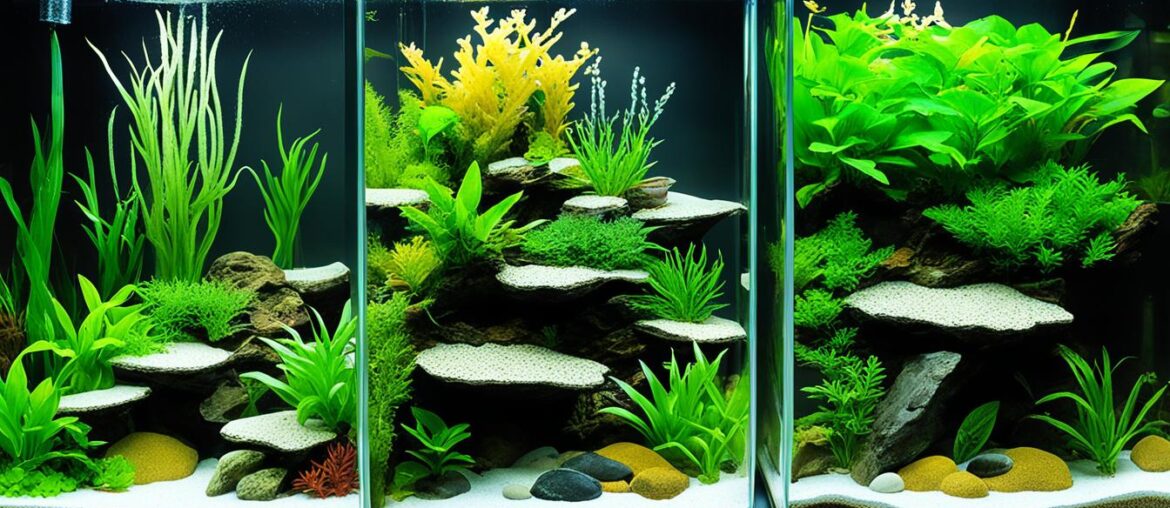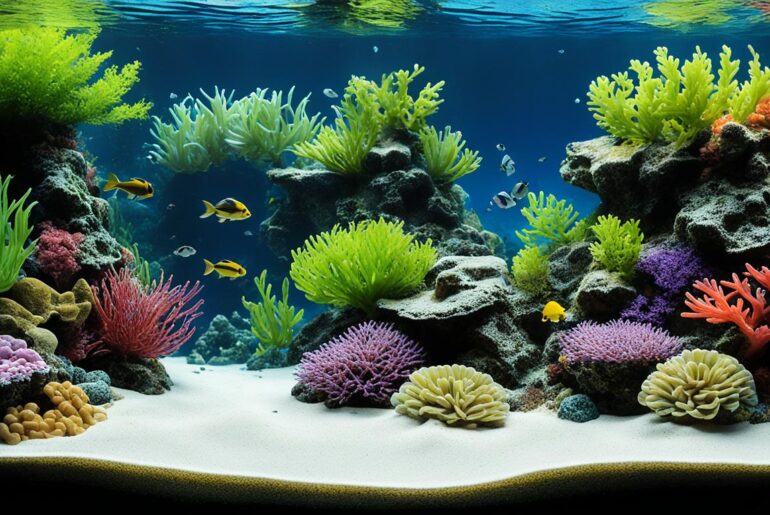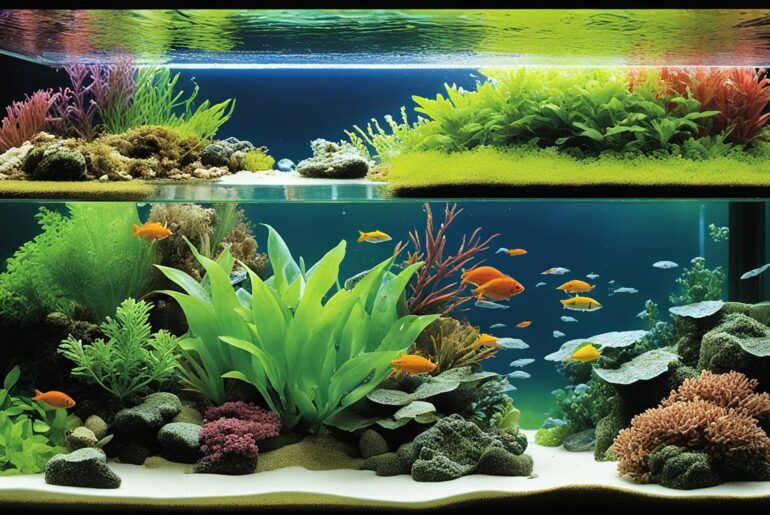I still remember the day I set up my very first freshwater tank. It was a blank canvas, waiting to be transformed into a vibrant underwater paradise. As I stood in front of the empty tank, I couldn’t help but wonder how the choice of substrate color would influence the overall appearance and ambiance of my aquatic masterpiece.
I had heard that dark substrates could create a natural and dramatic look, while light substrates could give the tank a bright and airy feel. But which option was truly the best for my freshwater tank? It was a dilemma that sparked my curiosity and set me on a journey to discover the impact of dark versus light substrate in freshwater tanks.
In this article, I will share with you three real-life examples of freshwater tank transformations that highlight the power of substrate color. Through these stories, we will explore the aesthetic and ecological effects of using dark versus light substrate in your own aquarium. Whether you’re a seasoned aquarist or just starting out, this article will help you make an informed decision when it comes to choosing the best substrate for your freshwater tank.
Key Takeaways:
- Choosing the right substrate color is essential for creating a visually appealing freshwater tank.
- Dark substrates can provide a natural and dramatic look, enhancing the colors of fish and plants.
- Light substrates can create a bright and airy atmosphere, ideal for tanks with light-loving plants.
- Consider the specific needs and preferences of your tank’s inhabitants when selecting the substrate color.
- Experiment with different substrate colors to find the perfect balance between aesthetics and ecology.
The Importance of Substrate Color in Aquariums
The color of the substrate in an aquarium plays a crucial role in the overall appearance of the tank. It not only creates a visually appealing environment but also influences the behavior and well-being of the fish and other inhabitants.
When it comes to the choice of substrate color, there are two primary options to consider: dark and light.
“The substrate color can dramatically transform the aesthetics of your aquarium while also influencing the overall ambiance.”
The Benefits of Dark Substrate
Dark substrates, such as black or brown gravel, are known for their ability to create a dramatic and natural-looking environment. They mimic the bottom of a lake or river, providing a sense of authenticity to the tank.
Furthermore, dark substrates have the power to enhance the colors of the fish and plants, making them stand out more against the backdrop. This adds depth and contrast to the aquarium, creating a visually stunning display.
Another advantage of dark substrate is its ability to hide debris and uneaten food. This helps keep the tank looking clean and well-maintained, reducing the need for frequent cleaning.
The Benefits of Light Substrate
On the other hand, light substrates like white or beige sand offer a different set of advantages. They provide a brighter and more vibrant look to the tank, creating an airy atmosphere that can make the space feel more open and spacious.
Light substrates also reflect light more efficiently, increasing the overall brightness of the tank. This is particularly beneficial for tanks with plants that require higher levels of light for photosynthesis. A light-colored substrate can help maximize the light available to the plants, promoting healthy growth and oxygen production within the tank.
When choosing between dark and light substrate for your freshwater tank, consider the specific needs and preferences of your fish and other tank inhabitants. Some species may benefit from the natural-looking environment of a dark substrate, while others may thrive in a brighter and more vibrant setting.
Experimentation is key, so don’t be afraid to try out different substrate colors to find the one that best complements your desired aesthetic and supports the health and well-being of your aquarium’s inhabitants.
Next, we will explore real-life examples of aquarium transformations to gain a deeper understanding of how substrate color can impact the overall appearance and ecology of the tank.
Advantages of Dark Substrate
When it comes to freshwater tanks, dark substrate options offer several advantages that can greatly enhance the aesthetics and functionality of your aquarium. Let’s explore why dark substrate is a popular choice among aquarium enthusiasts.
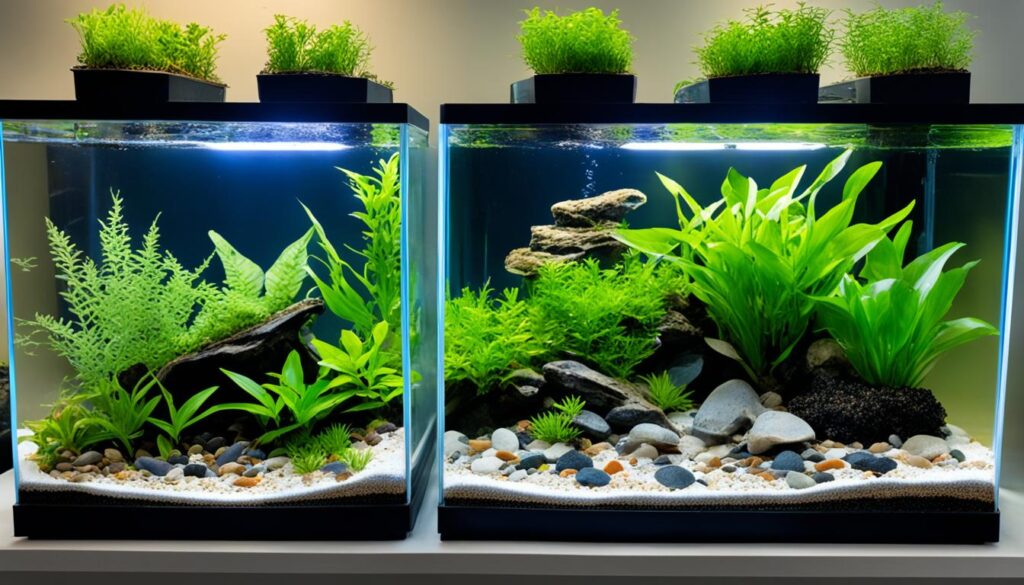
One of the key advantages of dark substrate is that it creates a natural-looking environment similar to the bottom of a lake or river. This adds a sense of authenticity to your tank, making it visually appealing and captivating to both you and your fish.
Furthermore, dark substrates have the ability to amplify the colors of your fish and plants, making them stand out more prominently. The contrast between the vibrant hues of your aquatic life and the dark backdrop enhances the overall beauty and visual impact of your tank.
In addition to aesthetics, dark substrate also offers practical benefits. It can effectively hide debris and uneaten food, giving your tank a cleaner appearance. The darker color helps mask any unsightly mess, reducing the need for frequent cleaning and maintaining a tidy and attractive aquarium.
So, whether you’re looking to create a natural aquatic environment or showcase the vibrant colors of your fish, dark substrate is definitely a worthwhile choice for your freshwater tank.
Benefits of Light Substrate
Light substrate offers several advantages for freshwater tanks. Let’s explore the benefits it brings:
- Creates a bright and airy atmosphere: Light-colored substrates, like white or beige sand, can give your tank a fresh and vibrant look. The bright colors reflect light, making the entire aquarium feel more spacious and inviting.
- Increases overall brightness: Light substrates have a reflective quality, bouncing light off their surface and illuminating the tank. This can be particularly advantageous for tanks with plants that require higher levels of light for photosynthesis.
By choosing a light-colored substrate, you can create a visually appealing aquarium that mimics a natural and well-lit underwater environment.
| Benefits of Light Substrate | Benefits of Dark Substrate |
|---|---|
| Creates a bright and airy atmosphere | Provides a natural-looking environment |
| Increases overall brightness | Enhances fish and plant colors |
Table: A comparison of the benefits of light and dark substrate in freshwater tanks.
The Visual Appeal of Light Substrate
Light substrate can significantly impact the aesthetics of your tank. The bright color creates a visually striking contrast against the vibrant colors of your fish and plants, making them stand out even more.
I love how the white sand in my aquarium enhances the colors of my tropical fish. They truly pop against the bright backdrop, creating a stunning visual display.
Furthermore, the reflective properties of light substrate can make your tank appear more lively. The enhanced brightness creates a captivating underwater world that draws attention to the fascinating creatures and beautiful decorations within.
Whether you choose a dark or light substrate for your freshwater tank ultimately depends on your desired aesthetic and the specific needs of your aquatic inhabitants. Consider experimenting with both options to find the perfect balance between visual appeal and ecosystem health.
Real-Life Example 1: The Guppy Aquarium
Let me take you through a real-life tank transformation – the “old fashioned” guppy aquarium. In this setup, I used clear water, number 3 grade aquarium gravel, and water sprite to create a stunning underwater environment.
Guppies are known for their vibrant and diverse colors, and the right substrate can make them stand out even more. While I opted for a light substrate in this particular setup, using a dark substrate would have also been an excellent choice.
Dark substrates, such as black or brown gravel, can provide a natural-looking environment. They can create a beautiful contrast against the vibrant colors of the guppies, making them the stars of your aquarium.
By using a dark substrate, you can showcase the true beauty of your guppies and create a visually striking aquarium that will impress anyone who lays eyes on it.
Whether you choose a light or dark substrate for your guppy aquarium, it’s important to provide a nutrient-rich base for their well-being. Guppies prefer a gravel substrate because it allows them to root and explore. It also helps maintain water stability and promotes healthy plant growth.
Remember, the choice of substrate color should align with your desired aesthetic and the overall theme of your aquarium. The main goal is to create an environment that brings out the natural beauty of your guppies while ensuring their happiness and vitality.
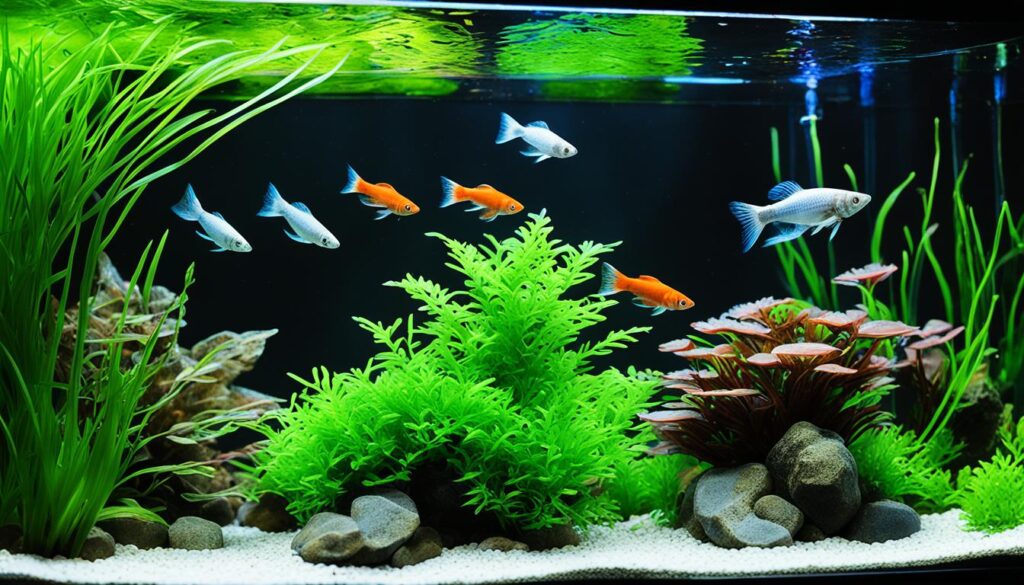
| Substrate Type | Advantages | Disadvantages |
|---|---|---|
| Light Substrate |
|
|
| Dark Substrate |
|
|
Real-Life Example 2: The Wild Livebearer Aquarium
One of the tank transformations we will explore is the creation of a habitat for wild livebearers. In this example, a mixed bed substrate composed of sand, silt, and gravel-sized materials was used to replicate their natural environment.
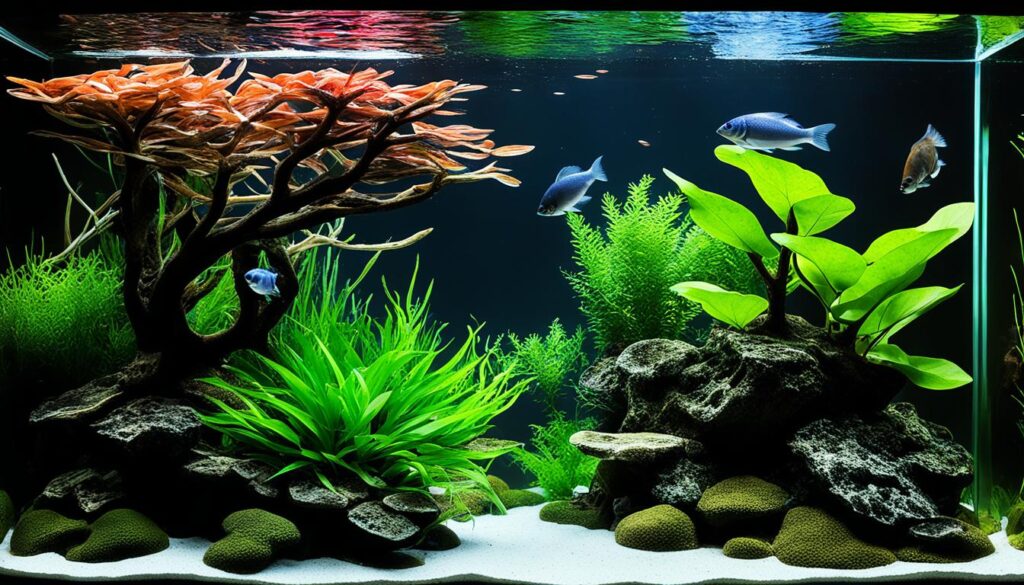
The choice of a light substrate was made to enhance the overall aesthetics and create a bright and vibrant atmosphere in the aquarium. This type of substrate can beautifully showcase the vibrant colors of the livebearers and create a visually appealing underwater world.
“The use of a light substrate in my wild livebearer aquarium has transformed the tank into a picturesque and captivating ecosystem. The contrasting colors of the fish against the light sand create a stunning visual display that never fails to impress visitors.”
– Aquarium enthusiast and owner of the wild livebearer aquarium, Jane Smith
Real-Life Example 3: The Mbuna Aquarium
In this real-life example, we will explore the transformation of an aquarium specifically designed for Mbuna cichlids. The choice of substrate plays a crucial role in creating a suitable environment for these colorful fish.
The Mbuna cichlids are native to rocky habitats in Lake Malawi, where they are known for their vibrant colors and striking patterns. To mimic their natural habitat, the tank utilized grey rocks and aragonite sand as the substrate.
The grey rocks provide a rocky structure, creating hiding places and territorial boundaries for the cichlids. It also adds a visually appealing element to the tank, replicating the rocky landscapes found in Lake Malawi.
On the other hand, the aragonite sand adds a touch of authenticity to the aquarium, mimicking the sandy bottoms commonly found in the rocky habitats. The fine particles of the sand create a natural-looking substrate that complements the Mbuna cichlids’ vibrant colors, making them the focal point of the tank.

By using a dark substrate, the Mbuna cichlids stand out against the contrasting colors of the rocks and sand, enhancing the visual appeal of the tank. This not only creates an aesthetically pleasing environment but also provides a stimulating and natural habitat for the fish.
The Mbuna Aquarium is a perfect example of how the right substrate choice can transform an aquarium, replicating the natural habitat of the fish while making them the main attraction.
| Substrate | Advantages |
|---|---|
| Grey rocks | – Creates hiding places and territorial boundaries – Adds a visually appealing rocky structure – Mimics the rocky landscapes of Lake Malawi |
| Aragonite sand | – Mimics the sandy bottoms of rocky habitats – Complements the vibrant colors of the Mbuna cichlids – Enhances the visual appeal of the tank |
“The Mbuna Aquarium showcases how a dark substrate can create a striking contrast, making the colorful cichlids the center of attention in the aquarium.”
When choosing a substrate for your own freshwater tank, consider the natural habitat and preferences of the fish species you are planning to keep. The Mbuna Aquarium is a prime example of how the right substrate choice can transform an aquarium into a visually stunning and biologically appropriate habitat.
Creating Your Own Transformed Aquarium
When it comes to choosing the substrate for your freshwater tank, there are a few factors to consider. Not only do you want to create an aesthetic that you’ll love, but you also need to think about the needs and preferences of the fish and other inhabitants in your tank.
One way to get started is by experimenting with different color substrates to see which one complements your desired theme or showcases the vibrant colors of your fish. Whether you opt for a dark substrate or a light one, each has its own unique benefits and visual effects.
Dark substrates, such as black or brown gravel, can create a dramatic and natural-looking environment. They mimic the bottom of a lake or river, providing a sense of depth and authenticity to your aquarium. Dark substrates also have the advantage of enhancing the colors of your fish and plants, making them stand out even more.
On the other hand, light substrates, like white or beige sand, can give your tank a brighter and more vibrant look. They create a sense of spaciousness and reflect light, which can provide a visually pleasing effect. This can be particularly advantageous if you have plants in your tank that require higher levels of light for photosynthesis.
Remember, it’s essential to consider the specific requirements of the plants and animals you plan to keep in your tank.
Choosing the Best Substrate for Freshwater Tanks
When selecting the best substrate for your freshwater tank, it’s crucial to prioritize both aesthetics and functionality. Here are a few key points to keep in mind:
- Consider the natural environment of the species you plan to house. Research their native habitats and try to replicate those conditions as closely as possible.
- Choose a substrate color that enhances the colors of your fish and plants, creating an impressive visual display.
- Ensure the substrate is suitable for the specific needs of your chosen aquatic plants. Some plants thrive in sandy substrates, while others prefer gravel or even clay-based substrates.
- Do your research on the compatibility of different types of substrate with your desired fish species. Some fish, such as bottom-dwelling species, may prefer a sandy substrate, while others, like cichlids, may prefer larger gravel or rocks.
- Consider the ease of maintenance. Dark substrates tend to hide debris and uneaten food better than light substrates, making them easier to clean.
By carefully considering these factors, you can create an underwater world that not only looks stunning but also provides a healthy and thriving environment for your aquatic friends.
Image:

Conclusion
The choice between dark and light substrate in freshwater tanks can have a significant impact on the overall appearance and ecology of the tank. When deciding on the ideal substrate color, it is essential to consider your specific goals and the needs of your tank’s inhabitants.
Dark substrates, such as black or brown gravel, provide a natural look and can enhance the colors of your fish and plants, making them stand out more. They also help to hide debris and uneaten food, giving your tank a cleaner appearance. On the other hand, light substrates like white or beige sand create a bright and airy atmosphere, making your tank feel more spacious and increasing the overall brightness.
When choosing the substrate for your fish tank, it’s crucial to experiment with different colors to create the desired aesthetic. Consider the behavior and preferences of your fish species, as well as the specific requirements of any plants you plan to keep in your tank. By doing so, you can create a thriving underwater ecosystem that not only looks beautiful but also supports the health and well-being of your aquatic inhabitants.
FAQ
What is the impact of using dark versus light substrate in freshwater tanks?
The choice of substrate color in an aquarium can dramatically affect the overall appearance and ecology of the tank. Dark substrates create a natural look and enhance the colors of fish and plants, while light substrates create a bright and airy atmosphere.
What are the advantages of using dark substrate in freshwater tanks?
Dark substrate provides a natural-looking environment similar to the bottom of a lake or river. It enhances the colors of fish and plants, makes debris and uneaten food less noticeable, and gives the tank a cleaner appearance.
What are the benefits of using light substrate in freshwater tanks?
Light substrate creates a bright and spacious atmosphere in the tank. It reflects light, increases overall brightness, and is beneficial for plants that require higher levels of light for photosynthesis.
Can you provide real-life examples of aquarium transformations using different substrate colors?
Certainly! We have three examples: the “old fashioned” guppy aquarium, the wild livebearer aquarium, and the Mbuna aquarium. Each showcases the impact of substrate color on the tank’s aesthetics and the well-being of the fish and other inhabitants.
How can I choose the right substrate color for my freshwater tank?
Consider the desired aesthetic and the needs of the fish and other inhabitants in your tank. Experiment with different colors to see which complements your desired theme or showcases the colors of your fish. Also, take into account the specific requirements of any plants you plan to include.
What are the best substrate options for freshwater tanks?
The best substrate options for freshwater tanks include dark substrates such as black or brown gravel and light substrates such as white or beige sand. Choose the option that aligns with your desired tank aesthetics and the needs of your tank’s inhabitants.
How can I create my own transformed aquarium?
To create your own transformed aquarium, start by selecting the desired substrate color based on the look you want to achieve and the needs of your tank’s inhabitants. Experiment with different substrate options, and consider adding appropriate decorations, plants, and fish to complement the chosen substrate color.
